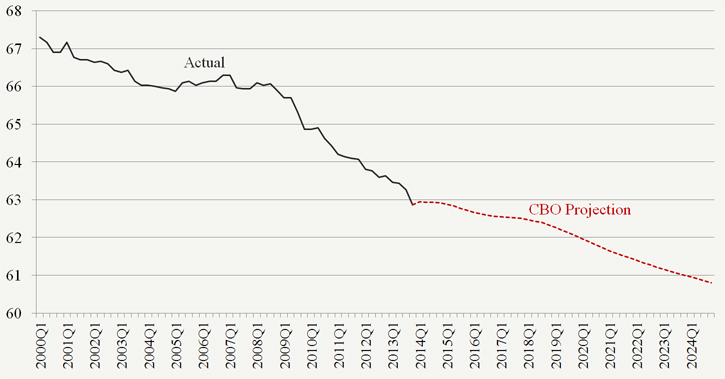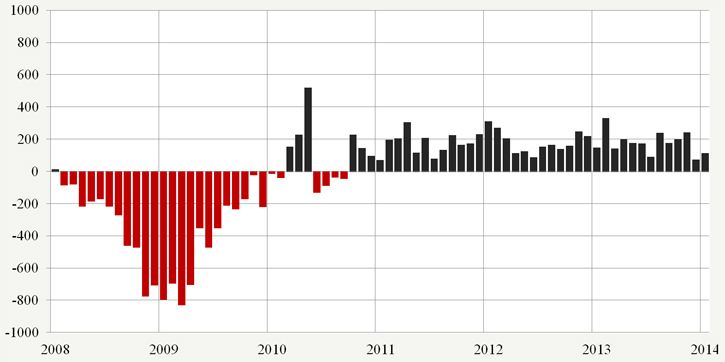February 7, 2014
January 2014 Jobs Report
Unemployment Rate: 6.6 percent
Unemployed Americans:10.2 million
Labor Force Participation
- The labor force participation rate is 63.0 percent, an increase of 0.2 percent from last month and remaining near the lowest level in 35 years. The civilian labor force rose by 499,000 in January, after declining by 347,000 in December.
- Based on a Congressional Budget Office’s (CBO) labor market report, the Wall Street Journal anticipates that only one-third of the millions who have dropped out of the labor force since the start of the recession in late 2007 will return in the years ahead, when the economy is stronger.
- The CBO predicts the labor force participation rate will continue to fall even after the economy recovers, down to 60.8 percent by the end of 2024.
Labor Force Participation Rate

- According to a paper from the Federal Reserve Bank of Boston, “workers that experience a job displacement of any length have substantially lower wages than non-displaced workers – an effect that persists for nearly 20 years after the unemployment episode.” This earnings gap is even more profound for the long-term unemployed.
- If the labor force participation rate were the same as when President Obama took office, the unemployment rate would be 10.5 percent.
- The “real” unemployment or U-6 rate is 12.7 percent for January 2014, down 0.4 percent from last month. This is the total percentage of unemployed and underemployed workers. President Obama promised a “natural unemployment” rate of 5.0 percent by now.
- The share of American adults with jobs in January was 58.8 percent, an increase of 0.2 from December. This is more than four percentage points below its pre-recession peak.
- The number of long-term unemployed is 3.6 million Americans, a decline of 232,000. This represents 35.8 percent of the unemployed – a decrease of 1.9 percent from last month. During the 1980s, when our country faced a similar recessionary period, the proportion of long-term unemployed never exceeded 27 percent.
- The January report could partially reflect that extended federal unemployment benefits expired for more than one million Americans at the end of December. To receive payments, people had to look for work actively, and were thus counted as part of the labor force. The drop in long-term unemployed could indicate these beneficiaries have now stopped looking.
- Additionally, concern has also been raised about the consistent number of Americans working part time for economic reasons – because they cannot find a full-time position or their hours have been cut back. This figure was near eight million throughout 2013.
- There were 837,000 people in January categorized as “discouraged workers,” an increase of 33,000 from January 2013. Discouraged workers are not currently looking for work because they believe no jobs are available for them.
Employment
- The Department of Labor reported an unemployment rate of 6.6 percent for January 2014, down 0.1 percent from December. It reported an increase of 113,000 nonfarm jobs -- weak job growth for the second straight month. Today’s job creation figure is lower than economists’ forecast of 189,000 new jobs. The employment figure for November was revised from 241,000 to 274,000 jobs created, with the figure for December was revised from 74,000 to 75,000 new jobs. Today’s report reflects the annual benchmarking process and updating of seasonal adjustment factors.
- The “real” number of unemployed Americans is 20.1 million. These are people who are unemployed (10.2 million), want work but have stopped searching for a job (2.6 million), or are working part time because they can’t find full time employment (7.3 million).
- According to the Wall Street Journal, today’s weak job report reflects a “slowdown that could heighten fears about the economic recovery and may lead some to call on the Federal Reserve to reconsider its easy-money strategy.” This continues concerns that more than four years into the economic recovery, the job market’s recovery remains far from complete as the unemployment rate remains near levels previously seen only during recessions.
Job Growth Is Still Insufficient
Change from previous month in thousands

- Last month, the Federal Reserve indicated it would further lower its monthly bond purchases by another $10 billion, following an initial reduction of $10 billion a month announced in December 2013. Combined, the Fed is now buying $65 billion a month, down from $85 billion a month, in Treasuries and mortgage bonds. The Board of Governors is scheduled to meet March 18-19.
- Employment in January increased in construction (+48,000), manufacturing (+21,000), and mining (+7,000). Employment in retail trade fell by 13,000, telecommunications fell by 10,000, and government (federal, state and local) employment fell by 29,000 last month; the U.S. Postal Service accounted for a loss of 9,000 jobs.
Weeks, Hours and Wages
- The average hourly private nonfarm payroll rose last month by five cents to $24.21. Year-over-year hourly earnings have risen 46 cents, or 1.9 percent.
- The average work week for private nonfarm employees was 34.4 hours, unchanged from December.
Next Article Previous Article
